Management Accounting Assignment | Solutions
VerifiedAdded on 2022/08/11
|10
|1870
|26
AI Summary
Hello expert, please want to answer the questions in the attached files As for the questions, they are related to finance and databases Note : I don't want references
Contribute Materials
Your contribution can guide someone’s learning journey. Share your
documents today.

Running Head: ACCOUNTING 1
ACCOUNTING
ACCOUNTING
Secure Best Marks with AI Grader
Need help grading? Try our AI Grader for instant feedback on your assignments.
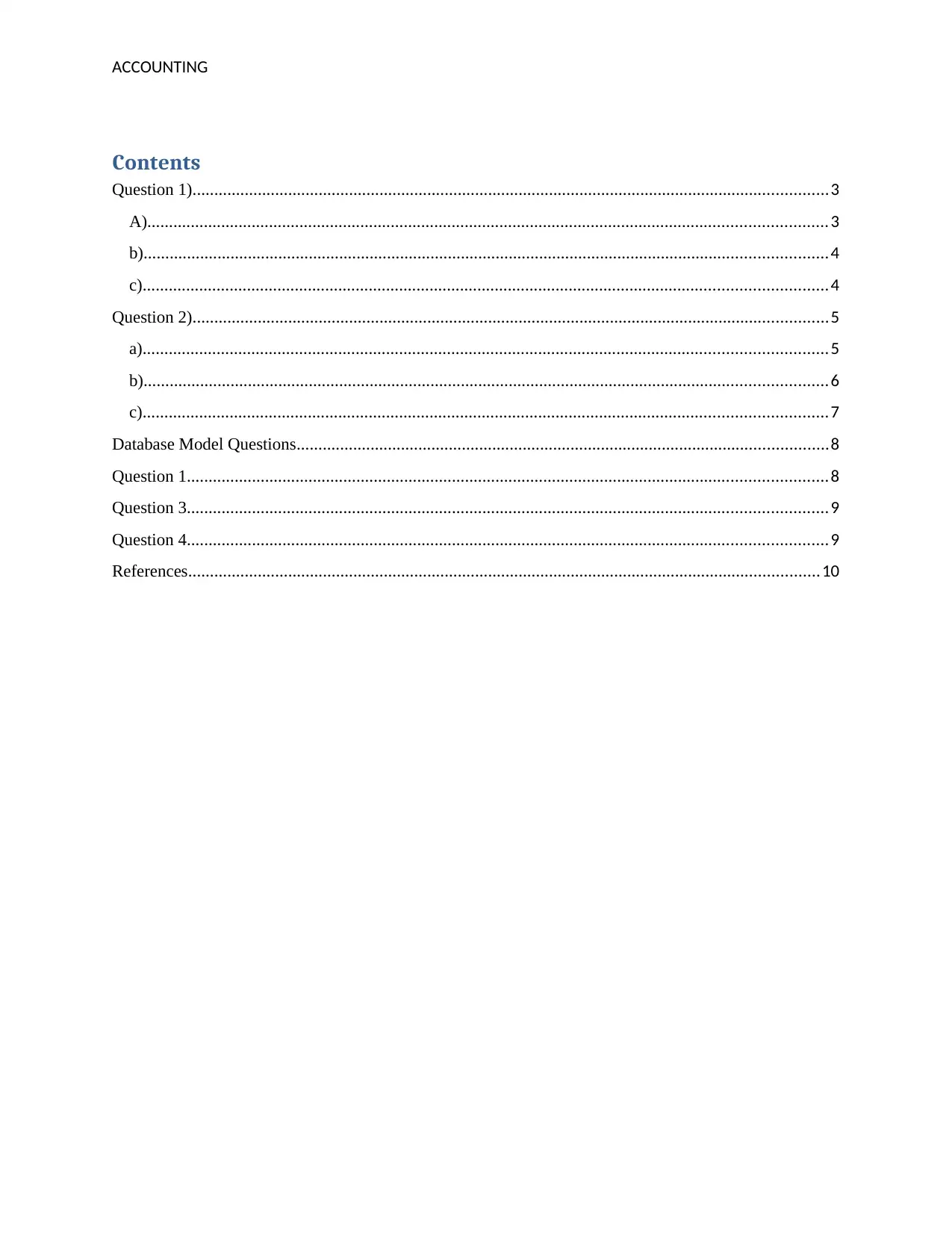
ACCOUNTING
Contents
Question 1)..................................................................................................................................................3
A)............................................................................................................................................................3
b).............................................................................................................................................................4
c).............................................................................................................................................................4
Question 2)..................................................................................................................................................5
a).............................................................................................................................................................5
b).............................................................................................................................................................6
c).............................................................................................................................................................7
Database Model Questions..........................................................................................................................8
Question 1...................................................................................................................................................8
Question 3...................................................................................................................................................9
Question 4...................................................................................................................................................9
References.................................................................................................................................................10
Contents
Question 1)..................................................................................................................................................3
A)............................................................................................................................................................3
b).............................................................................................................................................................4
c).............................................................................................................................................................4
Question 2)..................................................................................................................................................5
a).............................................................................................................................................................5
b).............................................................................................................................................................6
c).............................................................................................................................................................7
Database Model Questions..........................................................................................................................8
Question 1...................................................................................................................................................8
Question 3...................................................................................................................................................9
Question 4...................................................................................................................................................9
References.................................................................................................................................................10
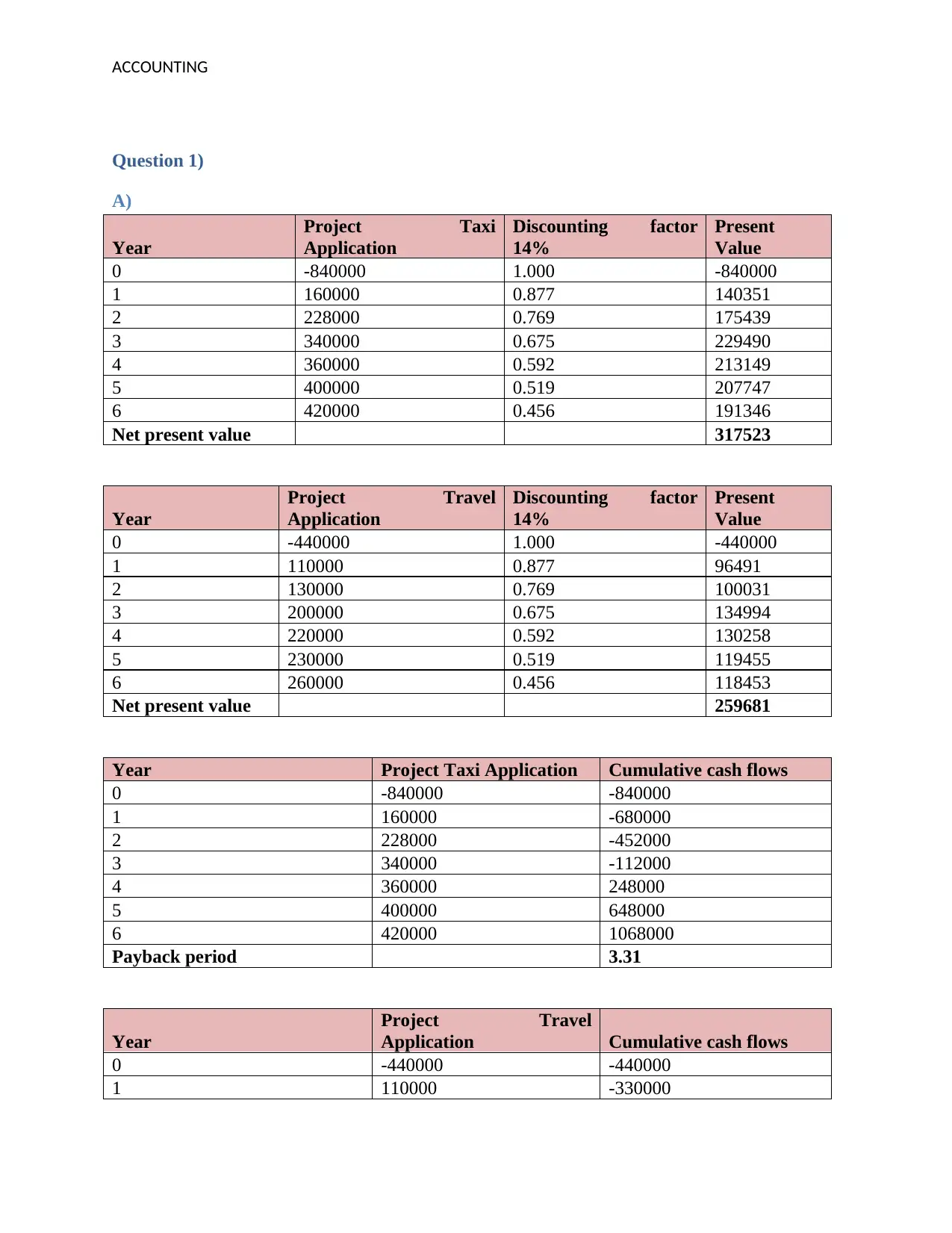
ACCOUNTING
Question 1)
A)
Year
Project Taxi
Application
Discounting factor
14%
Present
Value
0 -840000 1.000 -840000
1 160000 0.877 140351
2 228000 0.769 175439
3 340000 0.675 229490
4 360000 0.592 213149
5 400000 0.519 207747
6 420000 0.456 191346
Net present value 317523
Year
Project Travel
Application
Discounting factor
14%
Present
Value
0 -440000 1.000 -440000
1 110000 0.877 96491
2 130000 0.769 100031
3 200000 0.675 134994
4 220000 0.592 130258
5 230000 0.519 119455
6 260000 0.456 118453
Net present value 259681
Year Project Taxi Application Cumulative cash flows
0 -840000 -840000
1 160000 -680000
2 228000 -452000
3 340000 -112000
4 360000 248000
5 400000 648000
6 420000 1068000
Payback period 3.31
Year
Project Travel
Application Cumulative cash flows
0 -440000 -440000
1 110000 -330000
Question 1)
A)
Year
Project Taxi
Application
Discounting factor
14%
Present
Value
0 -840000 1.000 -840000
1 160000 0.877 140351
2 228000 0.769 175439
3 340000 0.675 229490
4 360000 0.592 213149
5 400000 0.519 207747
6 420000 0.456 191346
Net present value 317523
Year
Project Travel
Application
Discounting factor
14%
Present
Value
0 -440000 1.000 -440000
1 110000 0.877 96491
2 130000 0.769 100031
3 200000 0.675 134994
4 220000 0.592 130258
5 230000 0.519 119455
6 260000 0.456 118453
Net present value 259681
Year Project Taxi Application Cumulative cash flows
0 -840000 -840000
1 160000 -680000
2 228000 -452000
3 340000 -112000
4 360000 248000
5 400000 648000
6 420000 1068000
Payback period 3.31
Year
Project Travel
Application Cumulative cash flows
0 -440000 -440000
1 110000 -330000
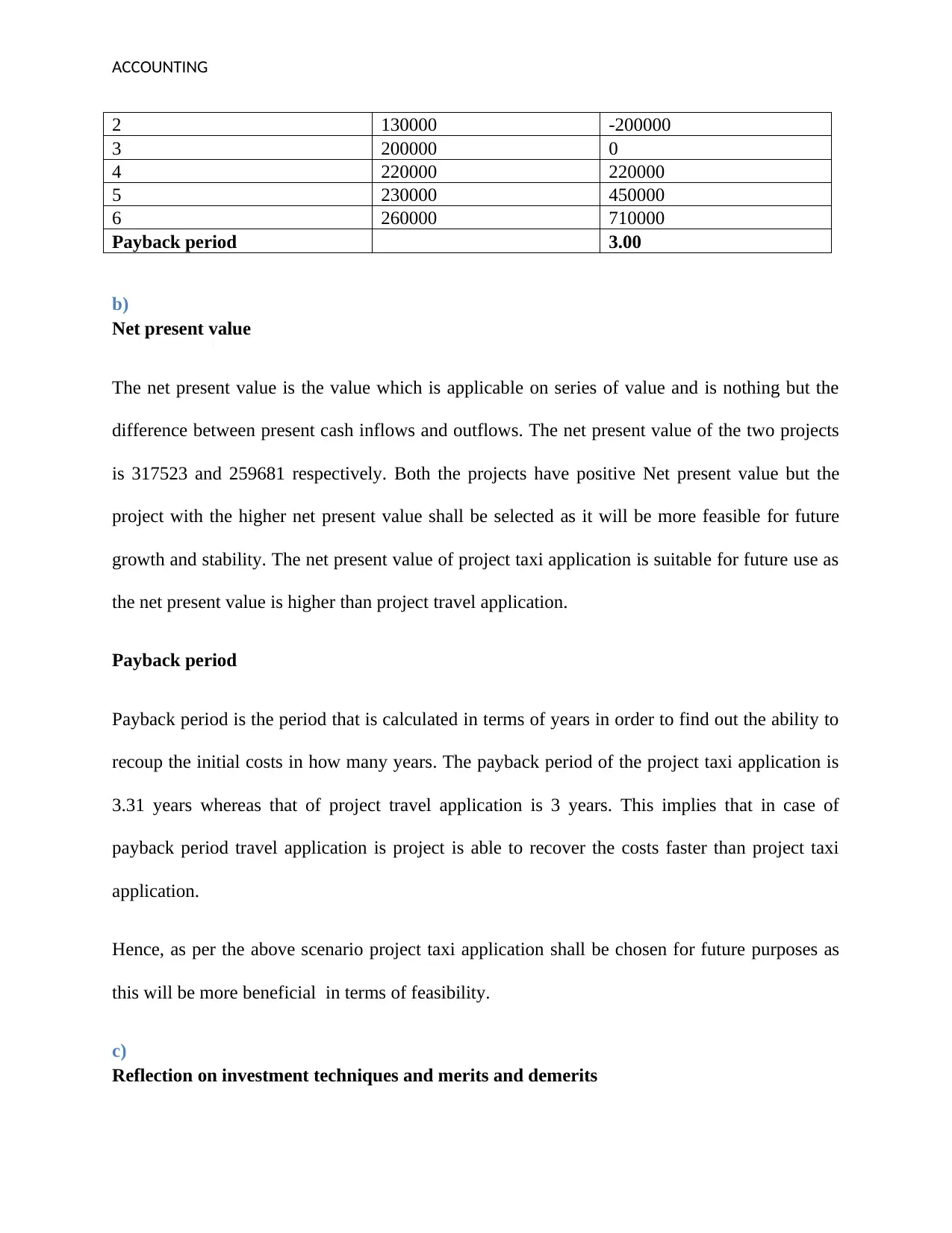
ACCOUNTING
2 130000 -200000
3 200000 0
4 220000 220000
5 230000 450000
6 260000 710000
Payback period 3.00
b)
Net present value
The net present value is the value which is applicable on series of value and is nothing but the
difference between present cash inflows and outflows. The net present value of the two projects
is 317523 and 259681 respectively. Both the projects have positive Net present value but the
project with the higher net present value shall be selected as it will be more feasible for future
growth and stability. The net present value of project taxi application is suitable for future use as
the net present value is higher than project travel application.
Payback period
Payback period is the period that is calculated in terms of years in order to find out the ability to
recoup the initial costs in how many years. The payback period of the project taxi application is
3.31 years whereas that of project travel application is 3 years. This implies that in case of
payback period travel application is project is able to recover the costs faster than project taxi
application.
Hence, as per the above scenario project taxi application shall be chosen for future purposes as
this will be more beneficial in terms of feasibility.
c)
Reflection on investment techniques and merits and demerits
2 130000 -200000
3 200000 0
4 220000 220000
5 230000 450000
6 260000 710000
Payback period 3.00
b)
Net present value
The net present value is the value which is applicable on series of value and is nothing but the
difference between present cash inflows and outflows. The net present value of the two projects
is 317523 and 259681 respectively. Both the projects have positive Net present value but the
project with the higher net present value shall be selected as it will be more feasible for future
growth and stability. The net present value of project taxi application is suitable for future use as
the net present value is higher than project travel application.
Payback period
Payback period is the period that is calculated in terms of years in order to find out the ability to
recoup the initial costs in how many years. The payback period of the project taxi application is
3.31 years whereas that of project travel application is 3 years. This implies that in case of
payback period travel application is project is able to recover the costs faster than project taxi
application.
Hence, as per the above scenario project taxi application shall be chosen for future purposes as
this will be more beneficial in terms of feasibility.
c)
Reflection on investment techniques and merits and demerits
Secure Best Marks with AI Grader
Need help grading? Try our AI Grader for instant feedback on your assignments.
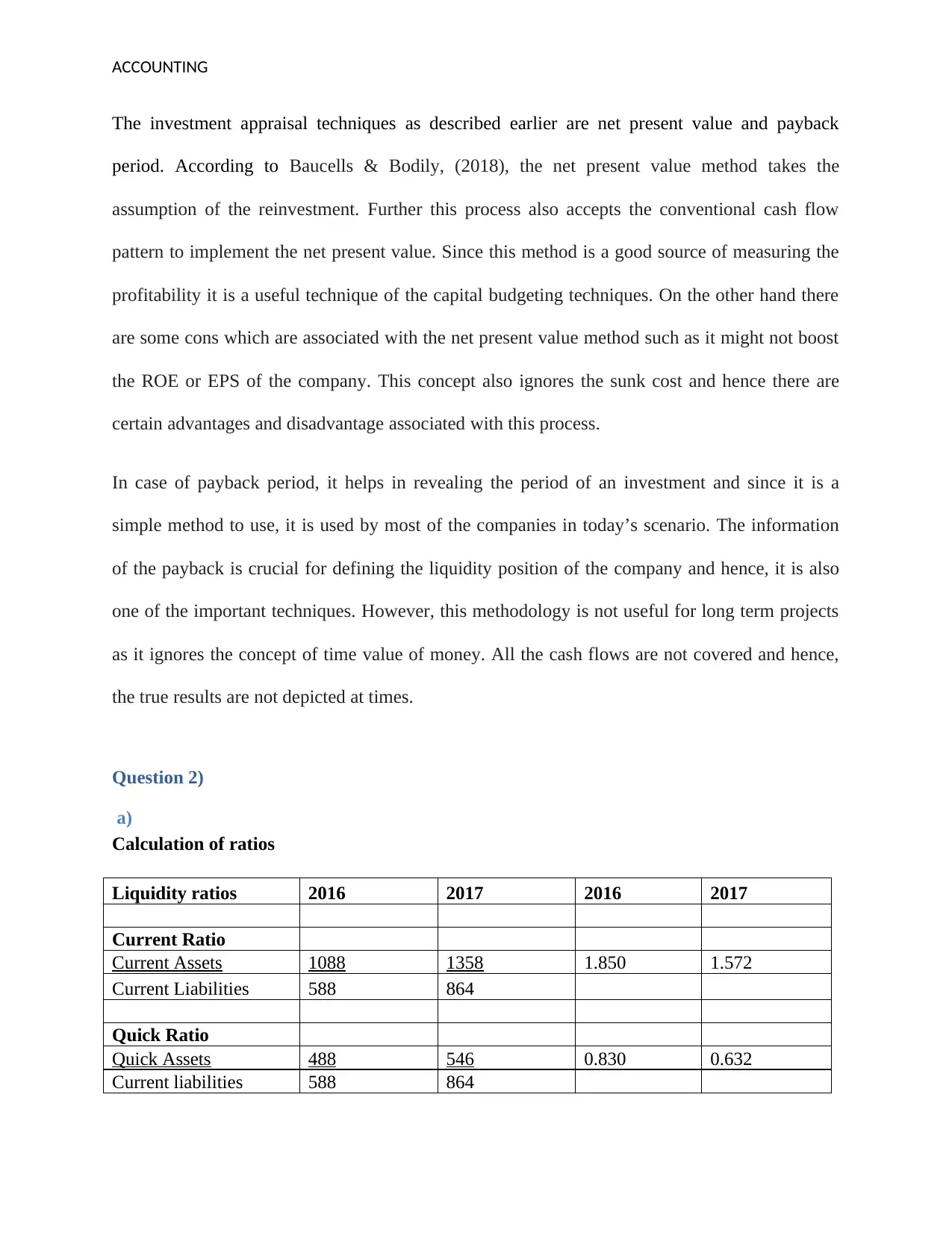
ACCOUNTING
The investment appraisal techniques as described earlier are net present value and payback
period. According to Baucells & Bodily, (2018), the net present value method takes the
assumption of the reinvestment. Further this process also accepts the conventional cash flow
pattern to implement the net present value. Since this method is a good source of measuring the
profitability it is a useful technique of the capital budgeting techniques. On the other hand there
are some cons which are associated with the net present value method such as it might not boost
the ROE or EPS of the company. This concept also ignores the sunk cost and hence there are
certain advantages and disadvantage associated with this process.
In case of payback period, it helps in revealing the period of an investment and since it is a
simple method to use, it is used by most of the companies in today’s scenario. The information
of the payback is crucial for defining the liquidity position of the company and hence, it is also
one of the important techniques. However, this methodology is not useful for long term projects
as it ignores the concept of time value of money. All the cash flows are not covered and hence,
the true results are not depicted at times.
Question 2)
a)
Calculation of ratios
Liquidity ratios 2016 2017 2016 2017
Current Ratio
Current Assets 1088 1358 1.850 1.572
Current Liabilities 588 864
Quick Ratio
Quick Assets 488 546 0.830 0.632
Current liabilities 588 864
The investment appraisal techniques as described earlier are net present value and payback
period. According to Baucells & Bodily, (2018), the net present value method takes the
assumption of the reinvestment. Further this process also accepts the conventional cash flow
pattern to implement the net present value. Since this method is a good source of measuring the
profitability it is a useful technique of the capital budgeting techniques. On the other hand there
are some cons which are associated with the net present value method such as it might not boost
the ROE or EPS of the company. This concept also ignores the sunk cost and hence there are
certain advantages and disadvantage associated with this process.
In case of payback period, it helps in revealing the period of an investment and since it is a
simple method to use, it is used by most of the companies in today’s scenario. The information
of the payback is crucial for defining the liquidity position of the company and hence, it is also
one of the important techniques. However, this methodology is not useful for long term projects
as it ignores the concept of time value of money. All the cash flows are not covered and hence,
the true results are not depicted at times.
Question 2)
a)
Calculation of ratios
Liquidity ratios 2016 2017 2016 2017
Current Ratio
Current Assets 1088 1358 1.850 1.572
Current Liabilities 588 864
Quick Ratio
Quick Assets 488 546 0.830 0.632
Current liabilities 588 864
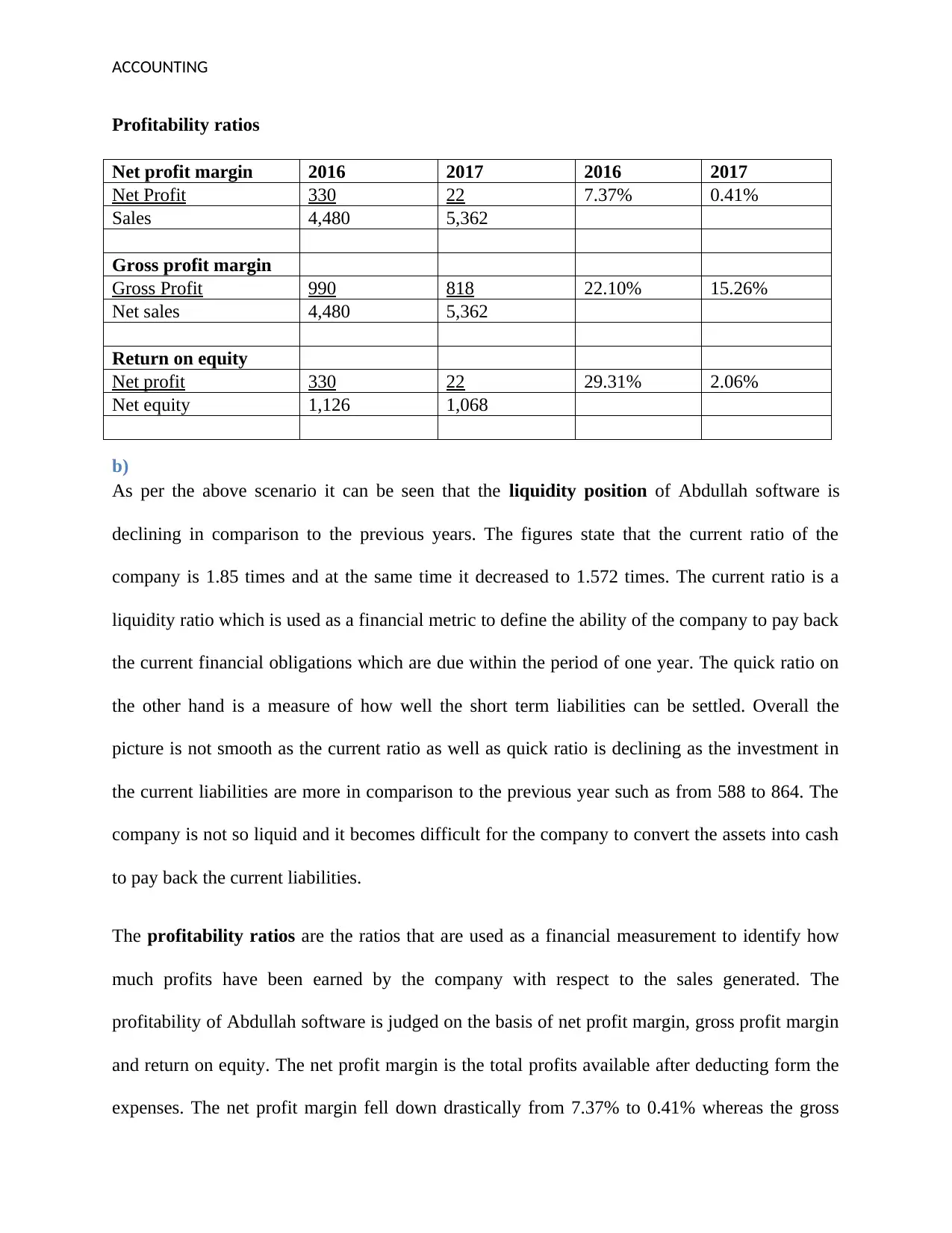
ACCOUNTING
Profitability ratios
Net profit margin 2016 2017 2016 2017
Net Profit 330 22 7.37% 0.41%
Sales 4,480 5,362
Gross profit margin
Gross Profit 990 818 22.10% 15.26%
Net sales 4,480 5,362
Return on equity
Net profit 330 22 29.31% 2.06%
Net equity 1,126 1,068
b)
As per the above scenario it can be seen that the liquidity position of Abdullah software is
declining in comparison to the previous years. The figures state that the current ratio of the
company is 1.85 times and at the same time it decreased to 1.572 times. The current ratio is a
liquidity ratio which is used as a financial metric to define the ability of the company to pay back
the current financial obligations which are due within the period of one year. The quick ratio on
the other hand is a measure of how well the short term liabilities can be settled. Overall the
picture is not smooth as the current ratio as well as quick ratio is declining as the investment in
the current liabilities are more in comparison to the previous year such as from 588 to 864. The
company is not so liquid and it becomes difficult for the company to convert the assets into cash
to pay back the current liabilities.
The profitability ratios are the ratios that are used as a financial measurement to identify how
much profits have been earned by the company with respect to the sales generated. The
profitability of Abdullah software is judged on the basis of net profit margin, gross profit margin
and return on equity. The net profit margin is the total profits available after deducting form the
expenses. The net profit margin fell down drastically from 7.37% to 0.41% whereas the gross
Profitability ratios
Net profit margin 2016 2017 2016 2017
Net Profit 330 22 7.37% 0.41%
Sales 4,480 5,362
Gross profit margin
Gross Profit 990 818 22.10% 15.26%
Net sales 4,480 5,362
Return on equity
Net profit 330 22 29.31% 2.06%
Net equity 1,126 1,068
b)
As per the above scenario it can be seen that the liquidity position of Abdullah software is
declining in comparison to the previous years. The figures state that the current ratio of the
company is 1.85 times and at the same time it decreased to 1.572 times. The current ratio is a
liquidity ratio which is used as a financial metric to define the ability of the company to pay back
the current financial obligations which are due within the period of one year. The quick ratio on
the other hand is a measure of how well the short term liabilities can be settled. Overall the
picture is not smooth as the current ratio as well as quick ratio is declining as the investment in
the current liabilities are more in comparison to the previous year such as from 588 to 864. The
company is not so liquid and it becomes difficult for the company to convert the assets into cash
to pay back the current liabilities.
The profitability ratios are the ratios that are used as a financial measurement to identify how
much profits have been earned by the company with respect to the sales generated. The
profitability of Abdullah software is judged on the basis of net profit margin, gross profit margin
and return on equity. The net profit margin is the total profits available after deducting form the
expenses. The net profit margin fell down drastically from 7.37% to 0.41% whereas the gross
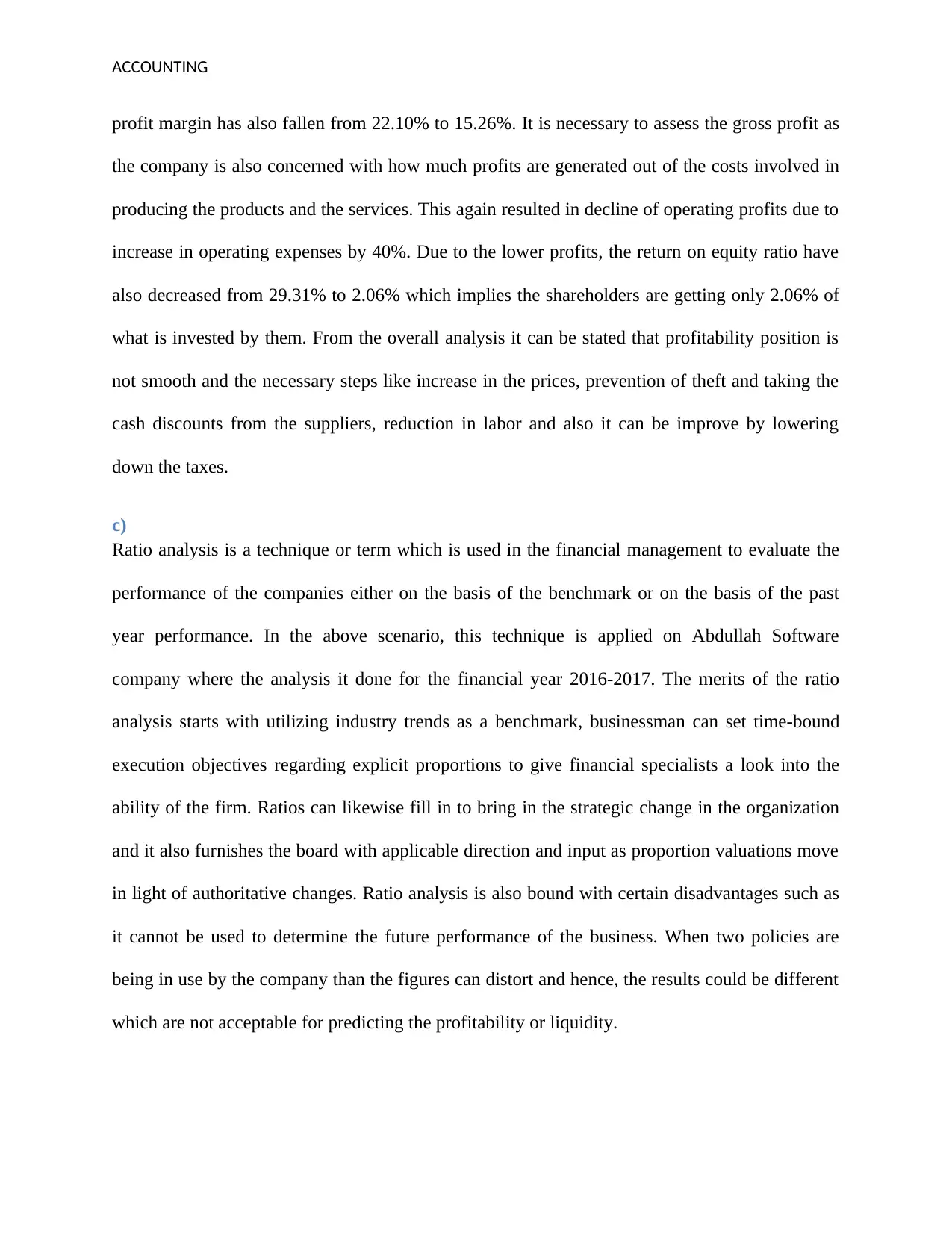
ACCOUNTING
profit margin has also fallen from 22.10% to 15.26%. It is necessary to assess the gross profit as
the company is also concerned with how much profits are generated out of the costs involved in
producing the products and the services. This again resulted in decline of operating profits due to
increase in operating expenses by 40%. Due to the lower profits, the return on equity ratio have
also decreased from 29.31% to 2.06% which implies the shareholders are getting only 2.06% of
what is invested by them. From the overall analysis it can be stated that profitability position is
not smooth and the necessary steps like increase in the prices, prevention of theft and taking the
cash discounts from the suppliers, reduction in labor and also it can be improve by lowering
down the taxes.
c)
Ratio analysis is a technique or term which is used in the financial management to evaluate the
performance of the companies either on the basis of the benchmark or on the basis of the past
year performance. In the above scenario, this technique is applied on Abdullah Software
company where the analysis it done for the financial year 2016-2017. The merits of the ratio
analysis starts with utilizing industry trends as a benchmark, businessman can set time-bound
execution objectives regarding explicit proportions to give financial specialists a look into the
ability of the firm. Ratios can likewise fill in to bring in the strategic change in the organization
and it also furnishes the board with applicable direction and input as proportion valuations move
in light of authoritative changes. Ratio analysis is also bound with certain disadvantages such as
it cannot be used to determine the future performance of the business. When two policies are
being in use by the company than the figures can distort and hence, the results could be different
which are not acceptable for predicting the profitability or liquidity.
profit margin has also fallen from 22.10% to 15.26%. It is necessary to assess the gross profit as
the company is also concerned with how much profits are generated out of the costs involved in
producing the products and the services. This again resulted in decline of operating profits due to
increase in operating expenses by 40%. Due to the lower profits, the return on equity ratio have
also decreased from 29.31% to 2.06% which implies the shareholders are getting only 2.06% of
what is invested by them. From the overall analysis it can be stated that profitability position is
not smooth and the necessary steps like increase in the prices, prevention of theft and taking the
cash discounts from the suppliers, reduction in labor and also it can be improve by lowering
down the taxes.
c)
Ratio analysis is a technique or term which is used in the financial management to evaluate the
performance of the companies either on the basis of the benchmark or on the basis of the past
year performance. In the above scenario, this technique is applied on Abdullah Software
company where the analysis it done for the financial year 2016-2017. The merits of the ratio
analysis starts with utilizing industry trends as a benchmark, businessman can set time-bound
execution objectives regarding explicit proportions to give financial specialists a look into the
ability of the firm. Ratios can likewise fill in to bring in the strategic change in the organization
and it also furnishes the board with applicable direction and input as proportion valuations move
in light of authoritative changes. Ratio analysis is also bound with certain disadvantages such as
it cannot be used to determine the future performance of the business. When two policies are
being in use by the company than the figures can distort and hence, the results could be different
which are not acceptable for predicting the profitability or liquidity.
Paraphrase This Document
Need a fresh take? Get an instant paraphrase of this document with our AI Paraphraser
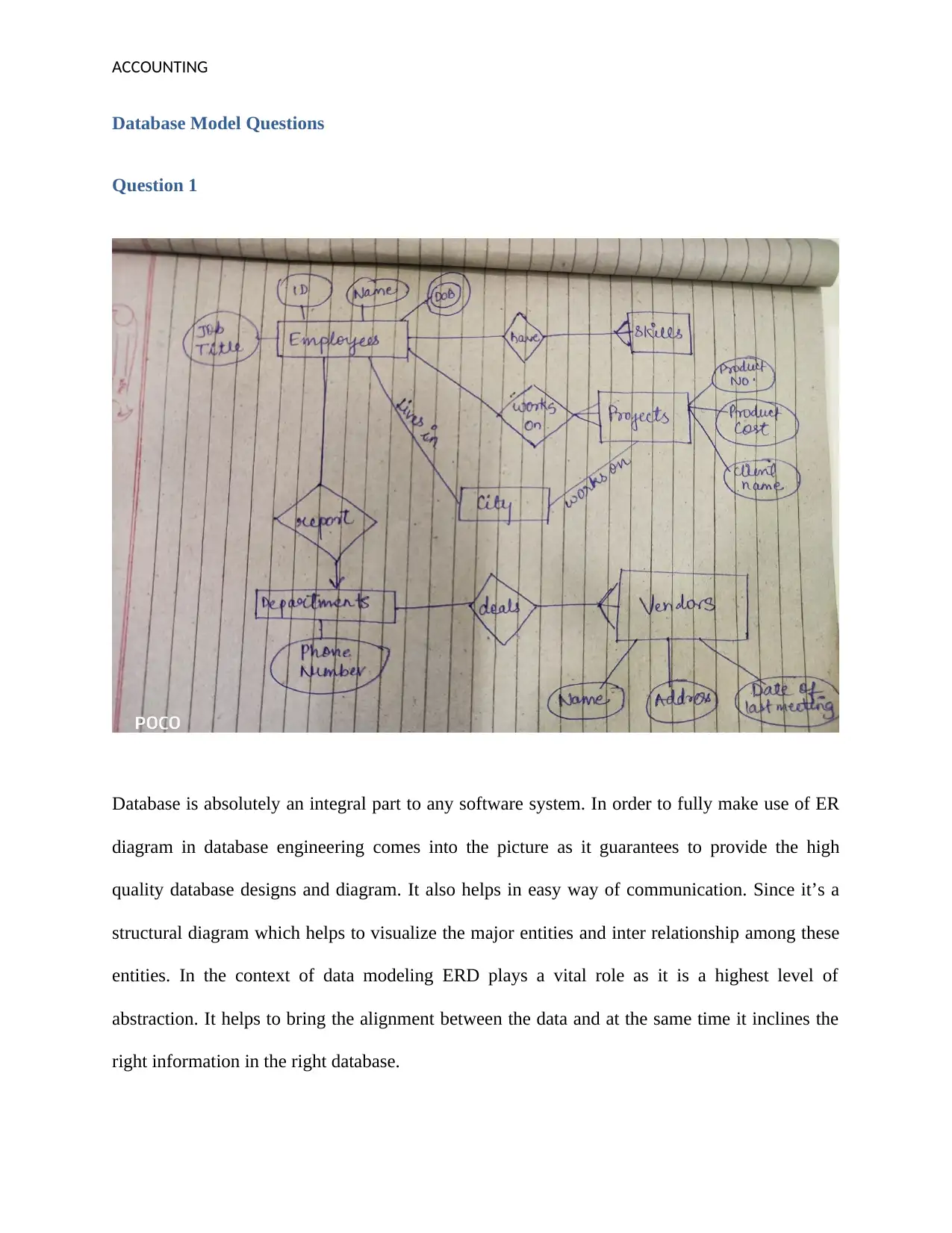
ACCOUNTING
Database Model Questions
Question 1
Database is absolutely an integral part to any software system. In order to fully make use of ER
diagram in database engineering comes into the picture as it guarantees to provide the high
quality database designs and diagram. It also helps in easy way of communication. Since it’s a
structural diagram which helps to visualize the major entities and inter relationship among these
entities. In the context of data modeling ERD plays a vital role as it is a highest level of
abstraction. It helps to bring the alignment between the data and at the same time it inclines the
right information in the right database.
Database Model Questions
Question 1
Database is absolutely an integral part to any software system. In order to fully make use of ER
diagram in database engineering comes into the picture as it guarantees to provide the high
quality database designs and diagram. It also helps in easy way of communication. Since it’s a
structural diagram which helps to visualize the major entities and inter relationship among these
entities. In the context of data modeling ERD plays a vital role as it is a highest level of
abstraction. It helps to bring the alignment between the data and at the same time it inclines the
right information in the right database.
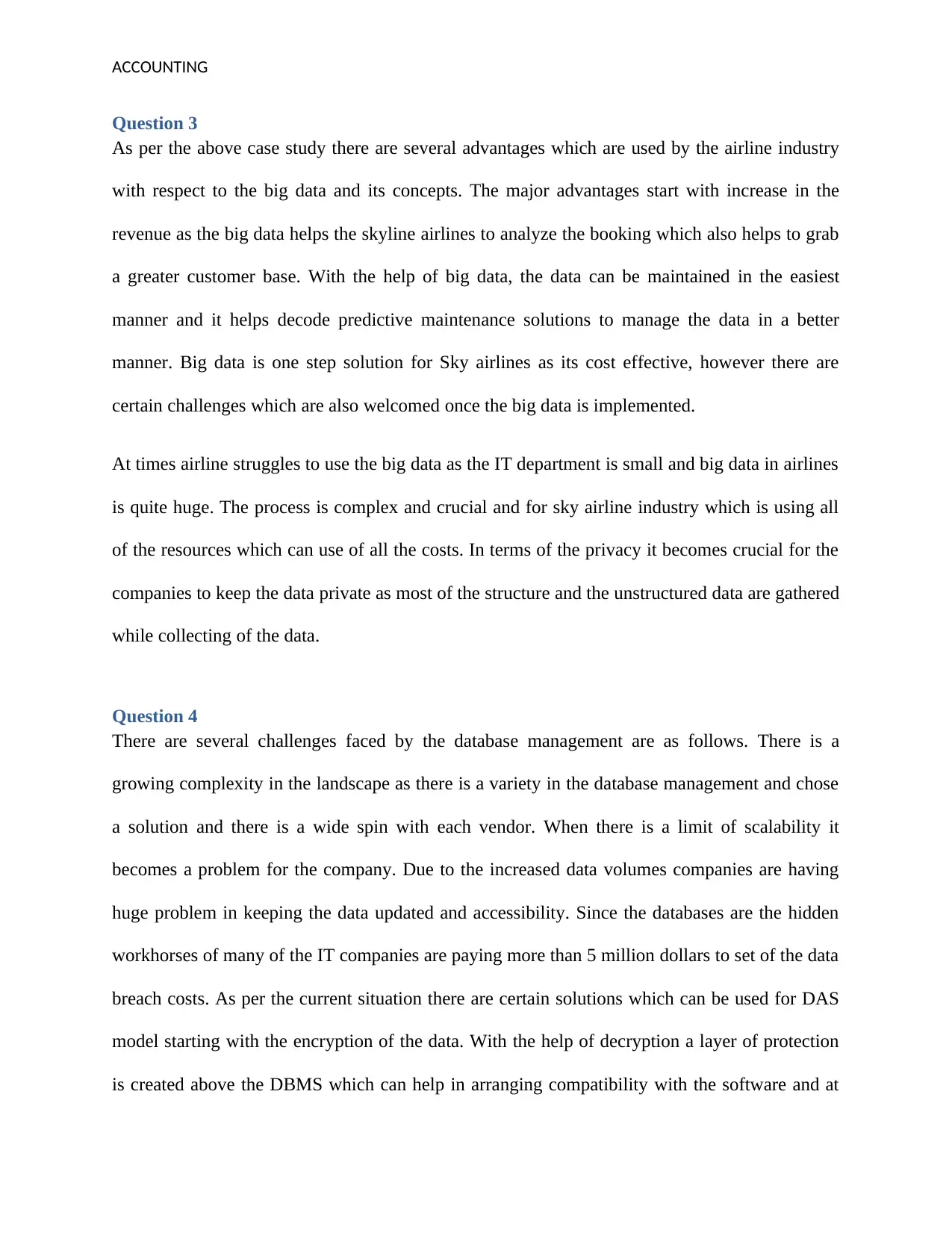
ACCOUNTING
Question 3
As per the above case study there are several advantages which are used by the airline industry
with respect to the big data and its concepts. The major advantages start with increase in the
revenue as the big data helps the skyline airlines to analyze the booking which also helps to grab
a greater customer base. With the help of big data, the data can be maintained in the easiest
manner and it helps decode predictive maintenance solutions to manage the data in a better
manner. Big data is one step solution for Sky airlines as its cost effective, however there are
certain challenges which are also welcomed once the big data is implemented.
At times airline struggles to use the big data as the IT department is small and big data in airlines
is quite huge. The process is complex and crucial and for sky airline industry which is using all
of the resources which can use of all the costs. In terms of the privacy it becomes crucial for the
companies to keep the data private as most of the structure and the unstructured data are gathered
while collecting of the data.
Question 4
There are several challenges faced by the database management are as follows. There is a
growing complexity in the landscape as there is a variety in the database management and chose
a solution and there is a wide spin with each vendor. When there is a limit of scalability it
becomes a problem for the company. Due to the increased data volumes companies are having
huge problem in keeping the data updated and accessibility. Since the databases are the hidden
workhorses of many of the IT companies are paying more than 5 million dollars to set of the data
breach costs. As per the current situation there are certain solutions which can be used for DAS
model starting with the encryption of the data. With the help of decryption a layer of protection
is created above the DBMS which can help in arranging compatibility with the software and at
Question 3
As per the above case study there are several advantages which are used by the airline industry
with respect to the big data and its concepts. The major advantages start with increase in the
revenue as the big data helps the skyline airlines to analyze the booking which also helps to grab
a greater customer base. With the help of big data, the data can be maintained in the easiest
manner and it helps decode predictive maintenance solutions to manage the data in a better
manner. Big data is one step solution for Sky airlines as its cost effective, however there are
certain challenges which are also welcomed once the big data is implemented.
At times airline struggles to use the big data as the IT department is small and big data in airlines
is quite huge. The process is complex and crucial and for sky airline industry which is using all
of the resources which can use of all the costs. In terms of the privacy it becomes crucial for the
companies to keep the data private as most of the structure and the unstructured data are gathered
while collecting of the data.
Question 4
There are several challenges faced by the database management are as follows. There is a
growing complexity in the landscape as there is a variety in the database management and chose
a solution and there is a wide spin with each vendor. When there is a limit of scalability it
becomes a problem for the company. Due to the increased data volumes companies are having
huge problem in keeping the data updated and accessibility. Since the databases are the hidden
workhorses of many of the IT companies are paying more than 5 million dollars to set of the data
breach costs. As per the current situation there are certain solutions which can be used for DAS
model starting with the encryption of the data. With the help of decryption a layer of protection
is created above the DBMS which can help in arranging compatibility with the software and at
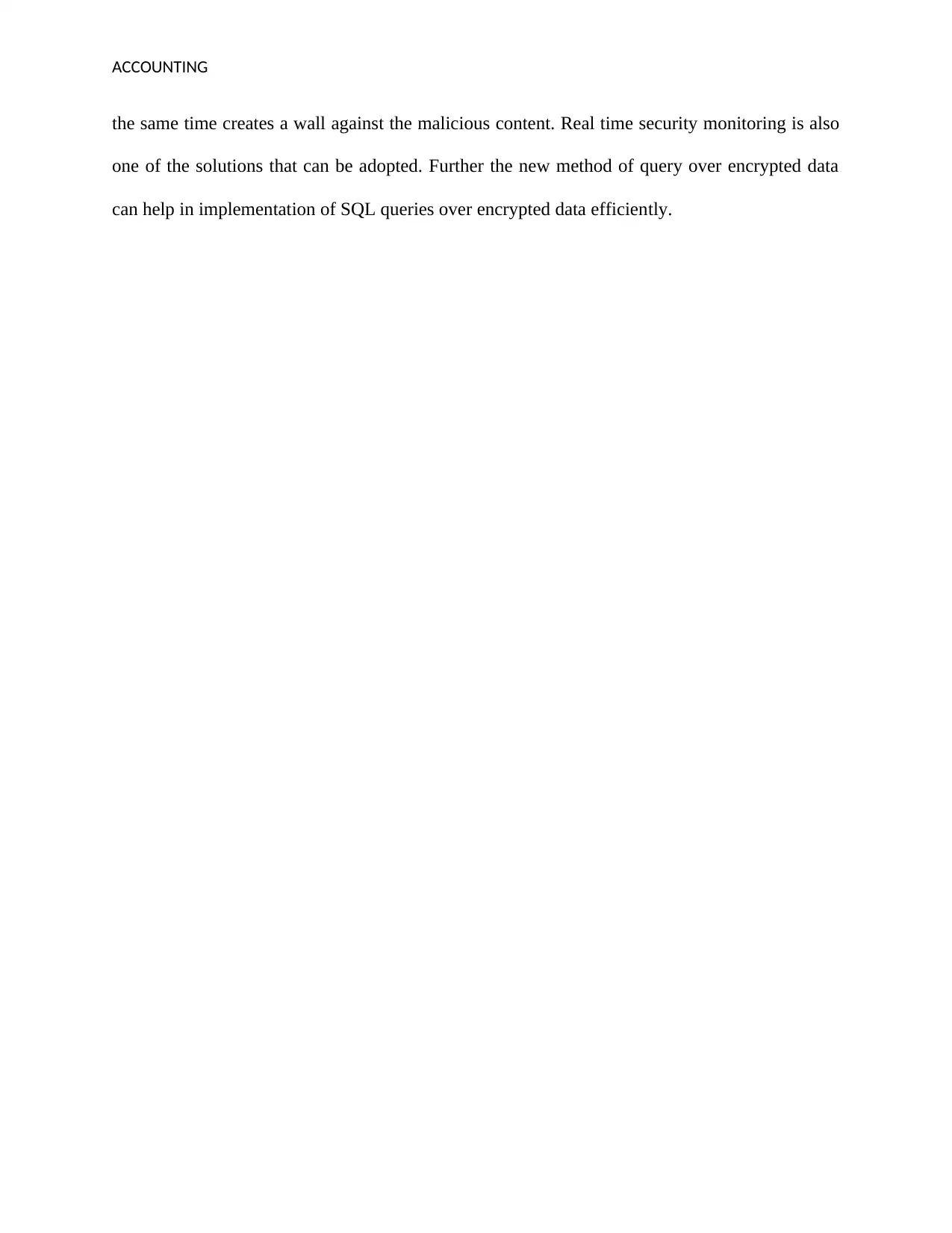
ACCOUNTING
the same time creates a wall against the malicious content. Real time security monitoring is also
one of the solutions that can be adopted. Further the new method of query over encrypted data
can help in implementation of SQL queries over encrypted data efficiently.
the same time creates a wall against the malicious content. Real time security monitoring is also
one of the solutions that can be adopted. Further the new method of query over encrypted data
can help in implementation of SQL queries over encrypted data efficiently.
1 out of 10
Related Documents
Your All-in-One AI-Powered Toolkit for Academic Success.
+13062052269
info@desklib.com
Available 24*7 on WhatsApp / Email
![[object Object]](/_next/static/media/star-bottom.7253800d.svg)
Unlock your academic potential
© 2024 | Zucol Services PVT LTD | All rights reserved.





